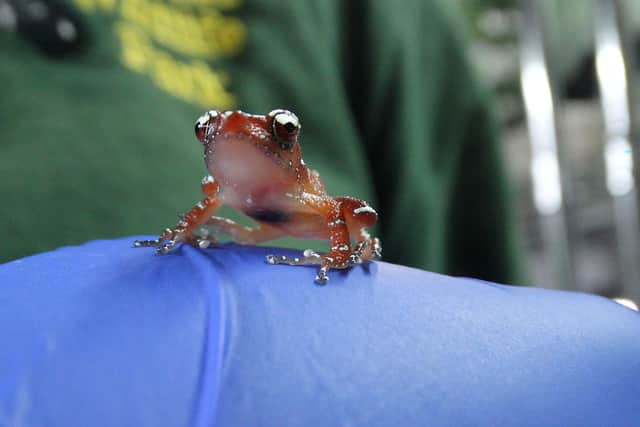Cinnamon frogs: UK wildlife park second in Europe to breed tiny frogs - as fungi puts population in peril
and live on Freeview channel 276
A tiny, speckled frog threatened by a deadly fungus which is wiping out amphibians across the globe has been successfully bred at an Oxfordshire wildlife park.
The cinnamon frog is native to southern Thailand, Malaysia, Singapore and Sumatra. The adults only grow to be about four centimetres long, and they are known for their distinct reddish-brown colour, and the black-and-white spots across their body. Once a widespread species, the cinnamon frog is now classified as near threatened with a decreasing population by the Encyclopedia of Life.
Advertisement
Hide AdAdvertisement
Hide AdKeepers at the Cotswold Wildlife Park in Burford have now once again bred a clutch of tiny cinnamon froglets, after it became only the second European zoo to successfully breed the species in captivity, in 2019. Only five other zoos in Europe keep the species at all, with just one other successfully breeding the frogs in the last 12 months, according to the park.


The froglets have all been named after different coloured spices - with keepers calling them Paprika, Cayenne, Saffron, Chipotle and Chilli. The wildlife park's general manager, Jamie Craig, told PA the babies are now being looked after in a specialised amphibian breeding room.
“Our dedicated reptile team have been working hard to perfect breeding techniques in our Amphibian Room," he said. “Many frog species have incredibly specific requirements, and it is a testament to their hard work that they have now managed to replicate our previous success with the cinnamon frogs."
Mr Craig hoped that Cotswold Wildlife Park's captive population of cinnamon frogs may help experts learn more about the species. “With the perilous state of many amphibian species in the world due to the Chytrid fungus, any expertise garnered from the captive populations may well be important tools for the future of these fascinating creatures," he added.
Advertisement
Hide AdAdvertisement
Hide AdThe Chytrid fungus causes a disease called chytridiomycosis in amphibians, including frogs, toads, newts, and salamanders. The disease has proved to have a near 100% death rate in some populations, and has rapidly spread across the globe - with widespread cases in New Zealand, Australia, Europe, and the Americas, and less frequent cases in Asia and Africa.
The fungus, which does not affect humans, unfortunately is thought to have already wiped some 90 amphibian species out in the wild. Many experts consider it to be the most lethal wildlife pathogen in recorded history, according to Yale, and as of yet, humans have not discovered a surefire way to treat it.
Comment Guidelines
National World encourages reader discussion on our stories. User feedback, insights and back-and-forth exchanges add a rich layer of context to reporting. Please review our Community Guidelines before commenting.
